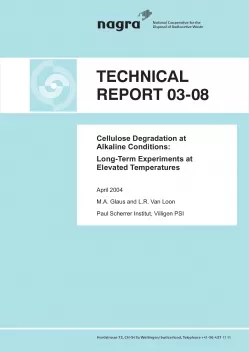
Technical Report NTB 03-08
Cellulose Degradation at Alkaline Conditions: Long-Term Experiments at Elevated Temperatures
The degradation of pure cellulose (Aldrich cellulose) and cotton cellulose at the conditions of an artificial cement pore water (pH 13.3) has been measured at 60 °C and 90 °C for reaction times between 1 and 2 years. The purpose of the experiments is to establish a reliable relationship between the reaction rate constant for the alkaline hydrolysis of cellulose (mid-chain scission), which is a slow reaction, and temperature. The reaction products formed in solution are analysed for the presence of the two diastereomers of isosaccharinic acid using high performance anion exchange chromatography combined with pulsed amperometric detection (HPAEC-PAD), other low-molecular weight aliphatic carboxylic acids using high performance ion exclusion chromatography (HPIEC) and for total organic carbon. The remaining cellulose solids are analysed for dry weight and degree of polymerisation. The degree of cellulose degradation as a function of reaction time is calculated based on total organic carbon and on the dry weight of the cellulose remaining.
The degradation of cellulose observed as a function of time can be divided in three reaction phases observed in the experiments: (i) an initial fast reaction phase taking a couple of days, (ii) a slow further reaction taking ~100 days and (iii) a complete stopping of cellulose degradation levelling-off at ~60 % of cellulose degraded. The experimental findings are unexpected in several respects: (i) The degree of cellulose degradation as a function of reaction time is almost identical for the experiments carried out at 60 ° C and 90 °C, and (ii) the degree of cellulose degradation as a function of reaction time is almost identical for both pure cellulose and cotton cellulose. It can be concluded that the reaction behaviour of the materials tested cannot be explained within the classical frame of a combination of the fast endwise clipping of monomeric glucose units (peeling-off process) and the slow alkaline hydrolysis at the temperatures tested here. It may be hypothesised that the alkaline hydrolysis has even not been observed in the experiments. However, if this is true, cellulose degradation proceeded via another unknown type of reaction. Mass balances for carbon show that the large majority of reaction products found in solution can be explained by formation of isosaccharinic acids and other low-molecular weight carboxylic acids.
With respect to long-term predictions for cellulose degradation at room temperature it can be concluded that the kinetic parameters for alkaline hydrolysis as proposed in the work of PAVASARS (Linköping Studies in Arts and Science, 196, Linköping University, Sweden, 1999) are too large and that complete cellulose degradation at these temperatures occurs only within time scales larger than hundreds of years. However, it is not possible from the experimental evidences, to corroborate the validity of a linear extrapolation (“Arrhenius equation”) of the reaction rates measured at temperatures between ~140 and 190 °C to room temperature, from which it was previously concluded that complete cellulose degradation would take time spans of the order of millions of years.
An interesting observation in the present experiments is the chemical instability of isosaccharinic acid at 90 ° C, which has been hypothetically interpreted as a fragmentation induced by the sorption of α-isosaccharinic acid on Ca(OH)2. Carbon mass balances show that -isosaccharinic acid is thereby transformed to other lowmolecular weight carboxylic acids. Such a reaction would be an interesting long-term perspective for performance assessment of the disposal of cellulose-containing radioactive waste, in that it may reduce the concentration of organic compounds strongly complexing radionuclides.
